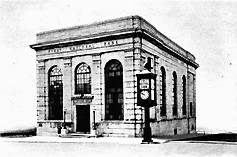Classical architecture means that a building uses elements found in Greek and Roman architecture. The use of columns, post & lintel structures, the pediment, and other formal style elements date back to ancient buildings such as the Greek Parthenon. Modern buildings that use these classical design elements often have the appearance of importance or a formal quality. Many government buildings and religious institutions in our country use these classical elements. They help recall the social and political ideas of classical society such as democracy.
Columns were first used as functional elements to hold up a ceiling or wall. Now they are mostly used to decorate a structure, yet they still can have a practical use. Now they can be used to hold up a basement ceiling or a porch awning. Greek column order (or style) include Doric (simple), Ionic (scroll) and Corinthian (fancy).
|
First National Bank (at left) was built in 1882 with a mansard style roof. It was originally the A.S. Benner home. It was purchased in 1902 by First National Bank. Part of the first floor was used as a bank and the second floor was remodeled for a residence and offices. This building was torn down in 1923. The building seen below was built in its place in 1923. Note the clock tower on the corner which was installed in 1924.  |
Pilasters are shallow, rectangular pillars which form a part of a wall from which it projects somewhat, and serving as support or decoration. Traditionally, pilasters are used to enhance a building, not do any actual support work of the structure. But these pilasters may provide some support for the building or structure. They also help to recall the symbolism of classical architecture. This building is reminiscent of the Greek Parthenon.
2001 Note: This building was purchased by the Borough of Perkasie in 2001. Plans are to return some of the building to the original style of the 1923 structure. The original open vaulted space in the main part of the building will be restored as well as the Walnut Street facade. New entrances and and other conveniences are planned to facilitate use of the building by the residents.